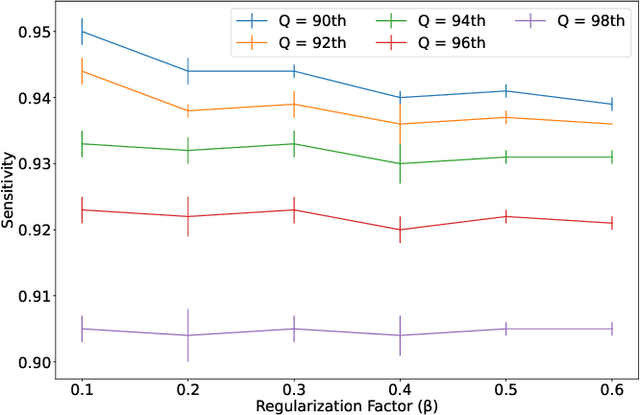Tsz-Yan Milly Lo
Collaborative learning of common latent representations in routinely collected multivariate ICU physiological signals
Feb 27, 2024Abstract:In Intensive Care Units (ICU), the abundance of multivariate time series presents an opportunity for machine learning (ML) to enhance patient phenotyping. In contrast to previous research focused on electronic health records (EHR), here we propose an ML approach for phenotyping using routinely collected physiological time series data. Our new algorithm integrates Long Short-Term Memory (LSTM) networks with collaborative filtering concepts to identify common physiological states across patients. Tested on real-world ICU clinical data for intracranial hypertension (IH) detection in patients with brain injury, our method achieved an area under the curve (AUC) of 0.889 and average precision (AP) of 0.725. Moreover, our algorithm outperforms autoencoders in learning more structured latent representations of the physiological signals. These findings highlight the promise of our methodology for patient phenotyping, leveraging routinely collected multivariate time series to improve clinical care practices.
VAE-IF: Deep feature extraction with averaging for unsupervised artifact detection in routine acquired ICU time-series
Dec 10, 2023Abstract:Artifacts are a common problem in physiological time-series data collected from intensive care units (ICU) and other settings. They affect the quality and reliability of clinical research and patient care. Manual annotation of artifacts is costly and time-consuming, rendering it impractical. Automated methods are desired. Here, we propose a novel unsupervised approach to detect artifacts in clinical-standard minute-by-minute resolution ICU data without any prior labeling or signal-specific knowledge. Our approach combines a variational autoencoder (VAE) and an isolation forest (iForest) model to learn features and identify anomalies in different types of vital signs, such as blood pressure, heart rate, and intracranial pressure. We evaluate our approach on a real-world ICU dataset and compare it with supervised models based on long short-term memory (LSTM) and XGBoost. We show that our approach achieves comparable sensitivity and generalizes well to an external dataset. We also visualize the latent space learned by the VAE and demonstrate its ability to disentangle clean and noisy samples. Our approach offers a promising solution for cleaning ICU data in clinical research and practice without the need for any labels whatsoever.
Hybrid Artifact Detection System for Minute Resolution Blood Pressure Signals from ICU
Mar 11, 2022


Abstract:Physiological monitoring in intensive care units generates data that can be used to aid clinical decision making facilitating early interventions. However, the low data quality of physiological signals due to the recording conditions in clinical settings limits the automated extraction of relevant information and leads to significant numbers of false alarms. This paper investigates the utilization of a hybrid artifact detection system that combines a Variational Autoencoder with a statistical detection component for the labeling of artifactual samples to automate the costly process of cleaning physiological recordings. The system is applied to mean blood pressure signals from an intensive care unit dataset recorded within the scope of the KidsBrainIT project. Its performance is benchmarked to manual annotations made by trained researchers. Our preliminary results indicate that the system is capable of consistently achieving sensitivity and specificity levels that surpass 90%. Thus, it provides an initial foundation that can be expanded upon to partially automate data cleaning in offline applications and reduce false alarms in online applications.
 Add to Chrome
Add to Chrome Add to Firefox
Add to Firefox Add to Edge
Add to Edge